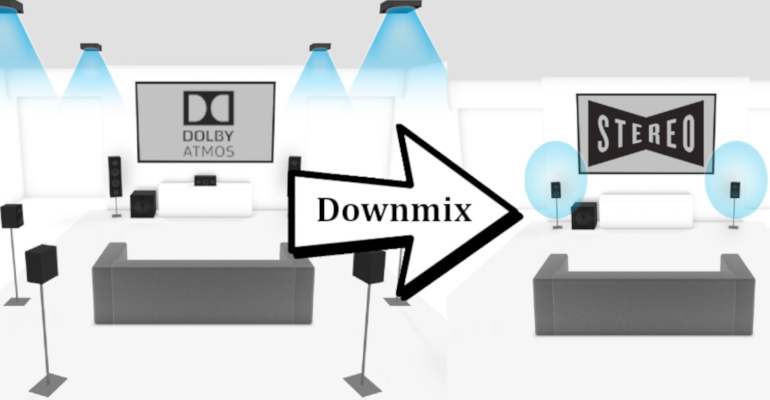Downmixing Dolby Atmos – What Are You Missing?
Dolby Atmos has allowed us to place a lot more speakers in our home theater systems. Up to nine floor-level and six overhead speakers with consumer-level gear. But not everyone has a full Atmos speaker setup. Heck, it is probably safe to say that very few people have seven floor-level speakers and four overhead speakers (the typical Atmos configuration). This means that when you are watching a movie or streaming a show in Dolby Atmos, the audio is being played by fewer speakers than is optimal and must be downmixed. If you have only two overhead speakers, instead of four, that’s one thing. But what if you have only a traditional 5.1 setup? Or, worse yet, only two speakers in a stereo setup? What are you missing? Honestly, less than you think. But let’s look at what is actually happening with the audio.
What Is Dolby Atmos?
Before we begin, we need to look at what Dolby Atmos audio actually is before we worry about how it is downmixed. Most people, based on how they post about it online, seem to think that Atmos is a channel-based audio format like all the formats we had in the past. That is not true. All the other formats out there (from stereo to DTS:MA/Dolby TrueHD) were channel-based. This means that the audio engineers would designate which speakers would play which sounds.
Atmos is an object-based audio system. Instead of the audio engineer placing sounds in individual speakers, they place them in a three-dimensional space. The Atmos software then determines which speakers play which sounds based on the coordinates of the sound origin and the speakers available in your room. In theory, as you add speakers, your systems’ ability to localize those sounds becomes more accurate. With current, consumer-level AV receivers and processors, we max out at around 7 to 9 floor-level speakers and six overhead speakers.
This is a simplified explanation, but it is enough for our purposes.
How Is Dolby Atmos Encoded?
If you read up on Atmos, you’ll hear people talk about a bed layer and an objects layer. The bed layer is your traditional seven floor-level speakers. Every Atmos mix has a bed layer. These are sounds that are hardcoded into specific speakers. The objects layer are sounds that are not assigned to speakers, but instead, get coordinates. The Atmos renderer then analyzes the available speakers and places these sounds in the room as best it can. If there is a speaker there, it uses that speaker. If there isn’t, it uses the nearest speakers to create a “phantom” speaker (exactly the same as if you had no center speaker). Could all sounds in the Atmos track be encoded as objects? Yes. But there are technological reasons why that bed layer is still used (check out this highly technical thread of engineers talking about encoding).

What Happens When You Downmix Dolby Atmos?
The concern is that the object layer is just “forgotten” or ignored when Dolby Atmos is downmixed to other speaker configurations. That’s not the case. When an Atmos mix is created, what is outputted isn’t two different layers. It is a single 7.1 (or 5.1) file (encoded in Dolby TrueHD for discs or Dolby Digital Plus for streaming). That file has every sound in the Atmos mix. The bed sounds as well as the object sounds.
Along with that file is metadata. That metadata is read by the Atmos decoder which then “lifts” the object sounds from the mix and attempts to render them using the 3D coordinates. Rather than thinking of Atmos being downmixed to your 7.1 or 5.1 system, think of Dolby Atmos as upmixing the objects into your overhead speakers!
The sound engineer can use the bed layer to actually have sounds in different locations than would be in the Atmos mix! As the decoder reads the metadata, it actually cancels out the sound in the bed layer and recreates it. So if something sounded better in one place in the 7.1 mix, it could be placed there in the bed layer. The object layer could have it in a completely different place!
What About Moving from 7.1 to 5.1 to Stereo?
As the sound engineer works on their Dolby Atmos track, they can switch between the different speaker configurations to test out how they sound. They can also adjust how those sounds are downmixed. If you have a 5.1 speaker configuration, the system can’t just take the surround back speaker information and play it out of the side surrounds at full volume. It needs to attenuate those sounds a little so that your surrounds don’t get overly loud. This is true as you move down to two speakers as well.
The sound engineers have complete control over how these downmixes are done. There are presets, but they can adjust them as they see fit. The key here is that no sounds are ever deleted. They are mixed into other speakers with the sound engineers having control over how it sounds.
Wrap Up
If you were worried that you were “losing sounds” by downmixing Dolby Atmos to your 5.1 or stereo system, fear not! All the sounds are still there! Even legacy AV receivers without access to Atmos decoding can still decode the bed layer. So if you have upgraditis based on a belief that you are “missing” Atmos sounds, you’re not. If you have the space for more speakers, and you are thinking of buying, we can help you choose the right ones.


